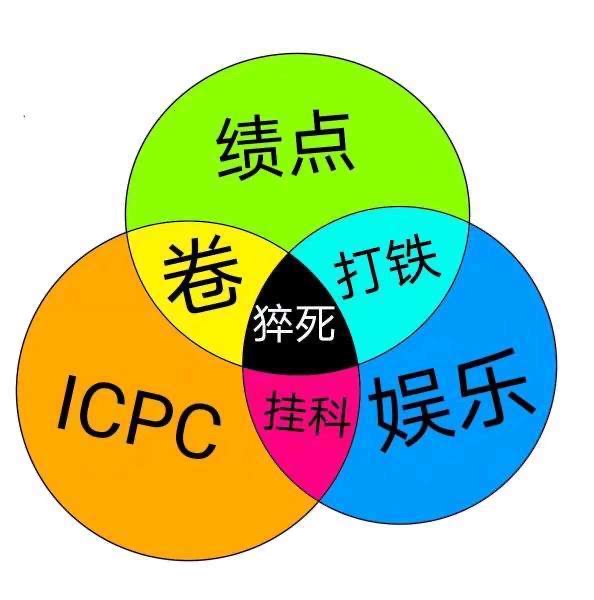题意 求关于 x 的同余方程 ax = 1(mod b) 的最小正整数解。
思路 ax+by = gcd , x*和y*可以用exgcd()求出
x = x* + k(b/gcd)
y = y* - k(a/gcd)
因为x为最小的正数,所以 x =((x*%b)+b)%b
代码 1 2 3 4 5 6 7 8 9 10 11 12 13 14 15 16 17 18 19 20 21 22 23 24 25 26 27 28 29 #include <vector> #include <iostream> #include <algorithm> #include <list> using namespace std;int exgcd (int a, int b, int &x, int &y) if (!b){ x = 1 , y = 0 ; return a; } int d = exgcd (b, a % b, x, y); int temp = x; x = y; y =temp - a / b * x; return d; } int main () int a,b,x,y; cin>>a>>b; exgcd (a,b,x,y); cout<<(x%b+b)%b<<endl; return 0 ; }
总结 x = x* + k(b/gcd)
y = y* - k(a/gcd)
思路 1 2 3 4 5 6 7 8 9 10 11 12 13 14 15 16 17 18 19 20 21 22 a:青蛙a的起点 b:青蛙b的起点 m:青蛙a一次能跳多远 n:青蛙b一次能跳多远 L:一圈的距离 (b-a):a要追b多少米 (m-n):每跳一次,a能追b多少米 x是总共跳了多少次 y是a追b不一定会在一圈内追完,而是追了y圈 (m - n)*x = b - a + y*L (m - n)*x - y*L = b - a ——————— — ————— 已知 已知 已知 扩展欧几里得求的是 ax+by=d a已知,b已知,d是a和b的最大公约数,求x,y 因此把上式的a替换乘(m-n),b替换成L。 式子变成(m-n)*x+(-y)*L=d 如果(b-a)%d不等于0,两只青蛙永远不会碰面 如果(b-a)%d等于零,把(m-n)*x+(-y)*L=d扩大(b-a)/d倍后,x就是结果。
代码 1 2 3 4 5 6 7 8 9 10 11 12 13 14 15 16 17 18 19 20 21 22 23 24 25 26 27 28 29 30 31 32 33 34 35 36 37 #include <vector> #include <iostream> #include <algorithm> #include <list> using namespace std;typedef long long LL;LL exgcd (LL a,LL b,LL &x, LL &y) if (!b){ x = 1 , y = 0 ; return a; } LL d = exgcd (b, a % b, x, y); LL temp = x; x = y; y =temp - a / b * x; return d; } int main () LL x,y,m,n,l,k,t; cin>>x>>y>>m>>n>>l; LL gcd = exgcd (n-m,l,k,t); if (abs (x-y)%abs (gcd)==0 ){ LL bei=(x-y)/gcd; l/=abs (gcd); printf ("%lld\n" ,(bei*k%l+l)%l); }else { printf ("Impossible\n" ); } return 0 ; }
总结 gcd可能算出来是负数,记得加abs
题意 如果一个数字的每一位都由 8 构成则该数字被称作是幸运数字。
现在给定一个正整数 L,请问至少多少个 8 连在一起组成的正整数(即最小幸运数字)是 L的倍数
思路 求解满足 $L \mid \underbrace{8 \cdots 8}_{x}$ 的最小正整数 $x$
于是原问题就变成了求解满足 $9 L I 8 \times\left(10^{x}-1\right)$ 的最小正整数 $x$
先不妨令 $A=10^{x}-1$, 则 $9 L \mid 8 A$
代码 1 2 3 4 5 6 7 8 9 10 11 12 13 14 15 16 17 18 19 20 21 22 23 24 25 26 27 28 29 30 31 32 33 34 35 36 37 38 39 40 41 42 43 44 45 46 47 48 49 50 51 52 53 54 55 56 57 58 59 60 61 62 63 64 65 66 67 #include <iostream> using namespace std;typedef long long LL;int gcd (LL a, int b) return b ? gcd (b, a % b) : a; } LL get_euler (LL c) { LL res = c; for (int i = 2 ; i <= c / i; ++ i) { if (c % i == 0 ) { int s = 0 ; while (c % i == 0 ) ++ s, c /= i; res = res / i * (i - 1 ); } } if (c > 1 ) res = res / c * (c - 1 ); return res; } LL qmul (LL a, LL b, LL c) { LL res = 0 ; while (b) { if (b & 1 ) res = (res + a) % c; a = (a + a) % c; b >>= 1 ; } return res; } LL qmi (LL a, LL b, LL c) { LL res = 1 ; while (b) { if (b & 1 ) res = qmul (res, a, c); a = qmul (a, a, c); b >>= 1 ; } return res; } int main () int T = 1 ; LL L; while (cin >> L, L) { int d = gcd (L, 8 ); LL c = 9 * L / d; LL phi = get_euler (c); LL res = 1e18 ; if (c % 2 == 0 || c % 5 == 0 ) res = 0 ; else { for (LL i = 1 ; i <= phi / i; ++ i) { if (phi % i == 0 ) { if (qmi (10 , i, c) == 1 ) res = min (res, i); if (qmi (10 , phi / i, c) == 1 ) res = min (res, phi / i); } } } printf ("Case %d: %lld\n" , T ++ , res); } return 0 ; }
思路 中国剩余定理
则
代码 1 2 3 4 5 6 7 8 9 10 11 12 13 14 15 16 17 18 19 20 21 22 23 24 25 26 27 28 29 30 31 32 33 34 35 36 37 38 39 40 41 42 43 44 45 46 47 #include <cstring> #include <iostream> #include <algorithm> using namespace std;typedef long long LL;const int N = 10 ;int n;int A[N], B[N];void exgcd (LL a, LL b, LL &x, LL &y) if (!b) x = 1 , y = 0 ; else { exgcd (b, a % b, y, x); y -= a / b * x; } } int main () scanf ("%d" , &n); LL M = 1 ; for (int i = 0 ; i < n; i ++ ) { scanf ("%d%d" , &A[i], &B[i]); M *= A[i]; } LL res = 0 ; for (int i = 0 ; i < n; i ++ ) { LL Mi = M / A[i]; LL ti, x; exgcd (Mi, A[i], ti, x); res += B[i] * Mi * ti; } cout << (res % M + M) % M << endl; return 0 ; }









